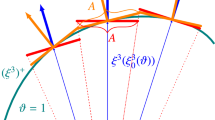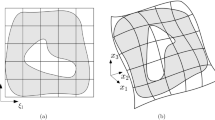Abstract
The classical asymptotic homogenization approach for linear elastic composites with discontinuous material properties is considered as a starting point. The sharp length scale separation between the fine periodic structure and the whole material formally leads to anisotropic elastic-type balance equations on the coarse scale, where the arising fourth rank operator is to be computed solving single periodic cell problems on the fine scale. After revisiting the derivation of the problem, which here explicitly points out how the discontinuity in the individual constituents’ elastic coefficients translates into stress jump interface conditions for the cell problems, we prove that the gradient of the cell problem solution is minor symmetric and that its cell average is zero. This property holds for perfect interfaces only (i.e., when the elastic displacement is continuous across the composite’s interface) and can be used to assess the accuracy of the computed numerical solutions. These facts are further exploited, together with the individual constituents’ elastic coefficients and the specific form of the cell problems, to prove a theorem that characterizes the fourth rank operator appearing in the coarse-scale elastic-type balance equations as a composite material effective elasticity tensor. We both recover known facts, such as minor and major symmetries and positive definiteness, and establish new facts concerning the Voigt and Reuss bounds. The latter are shown for the first time without assuming any equivalence between coarse and fine-scale energies (Hill’s condition), which, in contrast to the case of representative volume elements, does not identically hold in the context of asymptotic homogenization. We conclude with instructive three-dimensional numerical simulations of a soft elastic matrix with an embedded cubic stiffer inclusion to show the profile of the physically relevant elastic moduli (Young’s and shear moduli) and Poisson’s ratio at increasing (up to 100 %) inclusion’s volume fraction, thus providing a proxy for the design of artificial elastic composites.
Similar content being viewed by others
References
Allaire, G.: Homogenization and two-scale convergence. SIAM J. Math. Anal. 23(6), 1482–1518 (1992)
Auriault, J.L., Boutin, C., Geindreau, C.: Homogenization of Coupled Phenomena in Heterogenous Media, vol. 149. Wiley, Hoboken (2010)
Bakhvalov, N., Panasenko, G.: Homogenisation Averaging Processes in Periodic Media. Springer, Netherlands (1989)
Boresi, A.P., Chong, K., Lee, J.D.: Elasticity in Engineering Mechanics. Wiley, Washington (2010)
Bruna, M., Chapman, S.J.: Diffusion in spatial varying porous media. SIAM J. Appl. Math. 75(4), 1648–1674 (2015)
Burridge, R., Keller, J.: Poroelasticity equations derived from microstructure. J. Acoust. Soc. Am. 70, 1140–1146 (1981)
Cherkaev, A., Kohn, R.: Topics in the Mathematical Modelling of Composite Materials. Springer, New York (1997)
Cioranescu, D., Donato, P.: An Introduction to Homogenization. Oxford University Press, Oxford (1999)
Constantinescu, A., Korsunsky, A.: Elasticity with Mathematica: An Introduction to Continuum Mechanics and Linear Elasticity. Cambridge University Press, Cambridge (2007)
Dalwadi, M.P., Griffiths, I.M., Bruna, M.: Understanding how porosity gradients can make a better filter using homogenization theory. In: Proceedings of the Royal Society A, vol. 471, p. 20150464. The Royal Society (2015)
Den Toonder, J., Van Dommelen, J., Baaijens, F.: The relation between single crystal elasticity and the effective elastic behaviour of polycrystalline materials: theory, measurement and computation. Modell. Simul. Mater. Sci. Eng. 7(6), 909 (1999)
Eshelby, J.: The determination of the elastic field of an ellipsoidal inclusion, and related problems. Proc. R. Soc. Lond. Ser. A Math. Phys. Sci. 241, 376–396 (1957)
Francfort, G.A., Murat, F.: Homogenization and optimal bounds in linear elasticity. Arch. Ration. Mech. Anal. 94(4), 307–334 (1986)
Grimal, Q., Raum, K., Gerisch, A., Laugier, P.: A determination of the minimum sizes of representative volume elements for the prediction of cortical bone elastic properties. Biomech. Model. Mechanobiol. 10(6), 925–937 (2011)
Hashin, Z., Shtrikman, S.: A variational approach to the theory of the elastic behaviour of multiphase materials. J. Mech. Phys. Solids 11(2), 127–140 (1963)
Hazanov, S.: Hill condition and overall properties of composites. Arch. Appl. Mech. 68(6), 385–394 (1998)
Hill, R.: Elastic properties of reinforced solids: some theoretical principles. J. Mech. Phys. Solids 11(5), 357–372 (1963)
Hill, R.: New derivations of some elastic extremum principles. In: Progress in applied mechanics, The Prager anniversary volume, pp. 99–106. Macmillan, New York (1963)
Hill, R.: A self-consistent mechanics of composite materials. J. Mech. Phys. Solids 13(4), 213–222 (1965)
Holmes, M.: Introduction to Perturbation Method. Springer, New York (1995)
Hori, M., Nemat-Nasser, S.: On two micromechanics theories for determining micro–macro relations in heterogeneous solids. Mech. Mater. 31(10), 667–682 (1999)
Hull, D., Clyne, T.: An Introduction to Composite Materials. Cambridge University Press, Cambridge (1996)
Jones, R.M.: Mechanics of Composite Materials. CRC Press, Boca Rotan (1998)
Kohn, R.V., Lipton, R.: Optimal bounds for the effective energy of a mixture of isotropic, incompressible, elastic materials. Arch. Ration. Mech. Anal. 102(4), 331–350 (1988)
Mei, C.C., Vernescu, B.: Homogenization Methods for Multiscale Mechanics. World Scientific, Singapore (2010)
Milton, G.W.: The Theory of Composites, vol. 6. Cambridge University Press, Cambridge (2002)
Mori, T., Tanaka, K.: Average stress in matrix and average elastic energy of materials with misfitting inclusions. Acta Metall. 21(5), 571–574 (1973)
Murat, F.: H-convergence, séminaire danalyse fonctionnelle et numérique (1977/1978). Université dAlger, Multigraphed (1978)
Papanicolau, G., Bensoussan, A., Lions, J.L.: Asymptotic Analysis for Periodic Structures. Elsevier, Amsterdam (1978)
Peerlings, R., Fleck, N.: Computational evaluation of strain gradient elasticity constants. Int. J. Multiscale Comput. Eng. 2(4), 599–619 (2004)
Penta, R., Ambrosi, D., Quarteroni, A.: Multiscale homogenization for fluid and drug transport in vascularized malignant tissues. Math. Models Methods Appl. Sci. 25(1), 79–108 (2015)
Penta, R., Ambrosi, D., Shipley, R.J.: Effective governing equations for poroelastic growing media. Q. J. Mech. Appl. Math. 67(1), 69–91 (2014)
Penta, R., Gerisch, A.: Investigation of the potential of asymptotic homogenization for elastic composites via a three-dimensional computational study. Comput. Vis. Sci. 17(4), 185–201 (2016)
Penta, R., Raum, K., Grimal, Q., Schrof, S., Gerisch, A.: Can a continuous mineral foam explain the stiffening of aged bone tissue? A micromechanical approach to mineral fusion in musculoskeletal tissues. Bioinspir. Biomim. 11(3), 1–15 (2016)
Qu, J.: The effect of slightly weakened interfaces on the overall elastic properties of composite materials. Mech. Mater. 14(4), 269–281 (1993)
Reuss, A.: Berechnung der Fließgrenze von Mischkristallen auf Grund der Plastizitätsbedingung für Einkristalle. Zeitschrift für Angewandte Mathematik und Mechanik 9(1), 49–58 (1929)
Sanchez-Palencia, E.: Non-homogeneous Media and Vibration Theory, Lecture Notes in Physics, vol. 127. Springer, Verlag Berlin Heidelberg (1980)
Segurado, J., Llorca, J.: A numerical approximation to the elastic properties of sphere-reinforced composites. J. Mech. Phys. Solids 50(10), 2107–2121 (2002)
Shipley, R.J., Chapman, J.: Multiscale modelling of fluid and drug transport in vascular tumors. Bull. Math. Biol. 72, 1464–1491 (2010)
Slawinski, M.A.: Waves and Rays in Elastic Continua. World Scientific, Singapore (2010)
Tartar, L, Estimation de coefficients homogenises. In: Computing Methods in Applied Sciences and Engineering. Third International Symposium, December 5–9, 1977. Part 1, Lecture Notes in Mathematics, vol. 704, pp. 364–373. Springer, Verlag Berlin Heidelberg (1979). doi:10.1007/BFb0063609
Tiburtius, S., Schrof, S., Molnár, F., Varga, P., Peyrin, F., Grimal, Q., Raum, K., Gerisch, A.: On the elastic properties of mineralized turkey leg tendon tissue: multiscale model and experiment. Biomech. Model. Mechanobiol. 13, 1003–1023 (2014)
Voigt, W.: Ueber die Beziehung zwischen den beiden Elasticitätsconstanten isotroper Körper. Annalen der Physik und Chemie, Neue Folge 38, 573–587 (1888)
Zohdi, T.I., Wriggers, P.: An Introduction to Computational Micromechanics, vol. 20. Springer, Berlin (2008)
Author information
Authors and Affiliations
Corresponding author
Additional information
Communicated by Andreas Öchsner.
Rights and permissions
About this article
Cite this article
Penta, R., Gerisch, A. The asymptotic homogenization elasticity tensor properties for composites with material discontinuities. Continuum Mech. Thermodyn. 29, 187–206 (2017). https://doi.org/10.1007/s00161-016-0526-x
Received:
Accepted:
Published:
Issue Date:
DOI: https://doi.org/10.1007/s00161-016-0526-x




